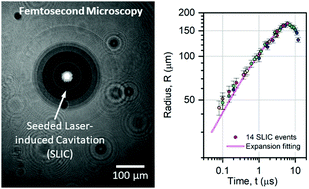Seeded laser-induced cavitation for studying high-strain-rate irreversible deformation of soft materials
Abstract
Characterizing the high-strain-rate and high-strain mechanics of soft materials is critical to understanding the complex behavior of polymers and various dynamic injury mechanisms, including traumatic brain injury. However, their dynamic mechanical deformation under extreme conditions is technically difficult to quantify and often includes irreversible damage. To address such challenges, we investigate an experimental method, which allows quantification of the extreme mechanical properties of soft materials using ultrafast stroboscopic imaging of highly reproducible laser-induced cavitation events. As a reference material, we characterize variably cross-linked polydimethylsiloxane specimens using this method. The consistency of the laser-induced cavitation is achieved through the introduction of laser absorbing seed microspheres. Based on a simplified viscoelastic model, representative high-strain-rate shear moduli and viscosities of the soft specimens are quantified across different degrees of crosslinking. The quantified rheological parameters align well with the time-temperature superposition prediction of dynamic mechanical analysis. The presented method offers significant advantages with regard to quantifying high-strain rate, irreversible mechanical properties of soft materials and tissues, compared to other methods that rely upon the cyclic dynamics of cavitation. These advances are anticipated to aid in the understanding of how damage and injury develop in soft materials and tissues.



 Please wait while we load your content...
Please wait while we load your content...
